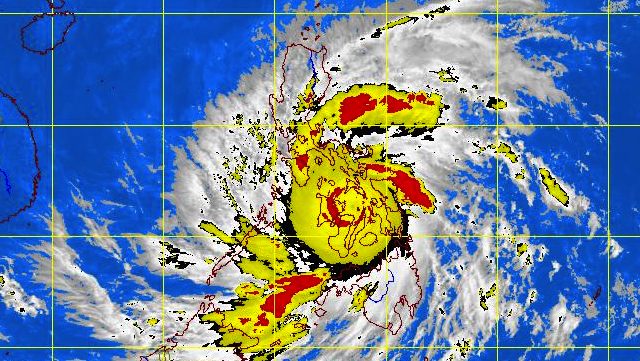SUMMARY
This is AI generated summarization, which may have errors. For context, always refer to the full article.

MANILA, Philippines – Possibly one of the strongest typhoons in recent history – this is how meteorologists are describing super typhoon Yolanda (international codename Haiyan), which is slicing through the Philippines’ central regions Friday, November 8.
“[It’s] perhaps the greatest wind damage any city on Earth has endured from a tropical cyclone in the past century,” according to Jeff Masters, the director of meteorology at US-based Weather Underground.
Television footage and posts on social media from the typhoon zone show pounding rain, howling winds, and flying debris, as millions huddled indoors.
An estimated 30 to 54 million people from southern Luzon down to northern Mindanao are affected, with around 5 million directly along the storm’s path. (READ: Yolanda seen to hit 5 M people the hardest)
As of 10 am Friday, Yolanda was located over Daanbantayan, Cebu, carrying maximum sustained winds of 215 kilometers per hour near the center and gusts of up to 250 km/h.
The storm is moving faster, at a speed of 40 km/h, towards the west northwest.
The center, or eye, of the typhoon has made landfall – or reached land – over Guiuan, Eastern Samar (4:40 am); then in the vicinity of Tolosa, Leyte (around 7 am), crossing Leyte, and onward to Daanbantayan, Cebu (9:40 am); it then moved on to Bantayan Island (10:40 am).
As it leaves northern Cebu, Yolanda is expected to travers the Visayan Sea and hit Panay around noon. It will then pass the southern part of Mindoro, then Busuanga, on its way out.
Heavy to intense rainfall is expected within the system’s 400 km diameter, and sea travel is risky in the areas affected, the bureau said.
Storm signals
Storm signal number 4, where winds of more than 185 km/h are expected within 12 hours, are currently in effect over:
- Northern Cebu
- Cebu City
- Bantayan Island
- Northern Negros Occidental
- Aklan
- Capiz
- Antique
- Iloilo
- Guimaras
- Southern parts of Oriental Mindoro and Occidental Mindoro
- Romblon
- Calamian Islands
- Masbate
Extensive damage is expected in these areas.
Storm signal number 3 is in effect over the following areas:
- Dinagat
- Northern Samar
- Eastern Samar
- Samar
- Leyte
- Southern Leyte
- Bohol
- The rest of Cebu
- Negros Oriental
- The rest of Negros Occidental
- Camotes Island
- Biliran
- The rest of Oriental Mindoro and Occidental Mindoro
- Burias Island
- Sorsogon
- Marinduque
- Ticao Island
- Northern Palawan
- Puerto Princesa City
Storm warning signal number 2 is hoisted over:
- Surigao del Norte
- Siargao
- Camiguin
- Siquijor
- Bataan
- Metro Manila
- Rizal
- Cavite
- Laguna
- Batangas
- Southern Quezon
- Camarines Sur
- Lubang Island
- Rest of Palawan
- Albay
These areas, meanwhile, are under storm warning signal number 1
- Surigao del Sur
- Misamis Oriental
- Agusan del Norte
- Pampanga
- Zambales
- Bulacan
- Camarines Norte
- The rest of Quezon
- Polilio Island
- Catanduanes
Storm warning signals elsewhere have been lowered, the bureau said.
Historic weather system

Based on the US military’s Joint Typhoon Warning Center the typhoon had maximum sustained winds of 315 km/h and gusts of up to 379 km/h, based on one-minute averages. (The Philippine state weather bureau uses 10-minute averages on wind speeds, hence the difference.)
The strength of the wind made it one of the 4 most powerful typhoons ever recorded in the world, and the most powerful to have made landfall, according to Masters.
Masters said he expected the damage in Guiuan, the fishing town of about 40,000 people that was the first to be hit after Yolanda swept in from the Pacific Ocean, to be “catastrophic”.
Communication with Guiuan was cut off immediately after Yolanda hit, and the civil defense office said it was too early to give an assessment of the damage there.
Masters said the previous record for the strongest typhoon to make landfall was Hurricane Camille, which hit Mississippi in the United States with winds of 190 miles (305 km) an hour in 1969.
Evacuations
More than 125,000 people in the most vulnerable areas had been moved to evacuation centers before Yolanda hit, according to the civil defense office, and millions of others braced for the typhoon in their homes.
Authorities said schools in the storm’s path were closed, ferry services suspended and fishermen ordered to secure their vessels.
In the capital of Manila, which was on the northern edge of the typhoon’s path, many schools were closed amid forecasts of heavy rain.
One particularly vulnerable area in Yolanda’s path was the central island of Bohol, the epicenter of a 7.2-magnitude earthquake last month that killed 222 people.
At least 5,000 survivors were still living in tents on Bohol, and they were moved to schools that had been turned into evacuation centers.
Other danger zones were the port cities of Cagayan de Oro and Iligan on the southern island of Mindanao, where flash floods induced by Tropical Storm Sendong (Washi) killed more than 1,000 people in December 2011.
Masters said warm waters of the Pacific Ocean were an important reason for the strength of Haiyan.
“It had very warm waters that extended to great depth, and favorable upper level winds that… acted to ventilate the storm, allowing large amounts of air to get sucked in near the surface and get carried away,” he wrote in an e-mail to Agence France-Presse.
But Masters said it was premature to blame climate change for Yolanda.
“The historical record of typhoons and hurricanes is too short and of too low quality to say if climate change may have played a role,” he said. – With reports from KD Suarez and Agence France-Presse / Rappler.com
Add a comment
How does this make you feel?
There are no comments yet. Add your comment to start the conversation.